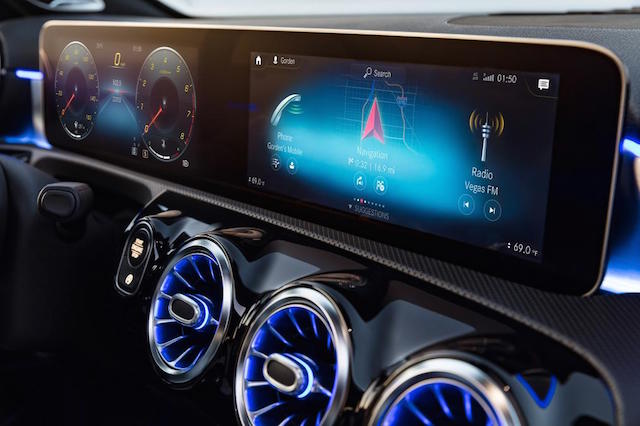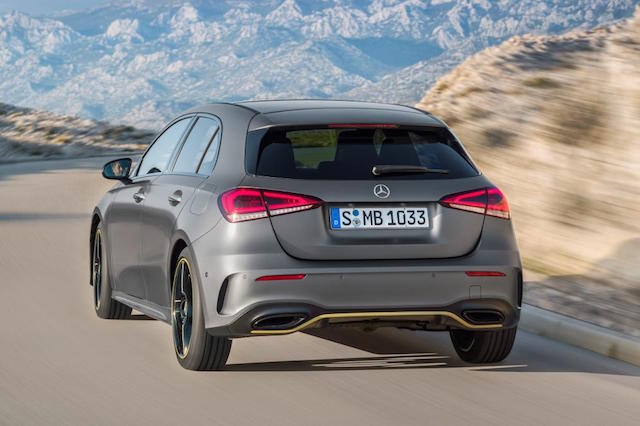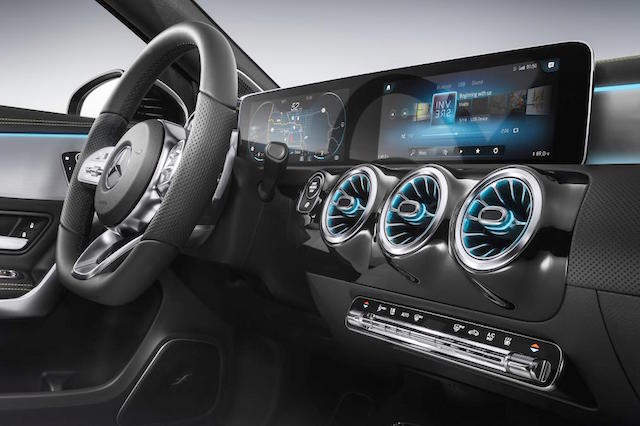
The fourth-generation A-Class hatchback might be what Mercedes-Benz calls a “new interpretation” of the design, but when it lands in New Zealand later this year it will be clearly seen as more revolutionary than evolutionary.
For starters, it introduces to the entire Benz fleet the MBUX (Mercedes-Benz User Experience) infotainment system, which uses artificial intelligence (AI) and will be available in every Benz within the next couple of years.
MBUX was publically unveiled at the Consumer Electronics Show in Las Vegas last month. It won’t be confined to new-generation Benz vehicles – its hardware and processors can be installed into existing models.
It learns the driver’s habits and choices through AI and can be personalised and adapted to each user. Depending on the model, the MBUX has either two 7.0-inch displays, two 12.5-inch displays or one of each.
One screen is ahead of the driver and the other in the centre of the dashboard. Both are driven by a graphics processing unit (GPU) from Nvidia, a supplier most famous for its gaming and computing GPUs.
MBUX has an interface that’s only two menu levels deep. A new natural language voice recognition system, similar to Amazon Alexa, Apple Siri and Google Assistant, is triggered by the key phrase “Hey Mercedes”. It can control most vehicle and infotainment functions.
Benz says the system can recognise everyday language, rather than just responding to set commands. For instance, not only will it respond to indirect comments like ‘I am cold’ rather than ‘temperature to 24 degrees’, it can also learn new words, as it takes information from both the onboard software and the cloud.
A new feature is ‘augmented reality’ navigation, which superimposes navigation information on top of a live video image taken by the front camera. Updates for the MBUX system can be delivered wirelessly, and don’t require the car to be serviced.
The A-Class can drive semi-autonomously in certain situations, thanks to driver-assistance and safety systems from the flagship S-Class saloon. For example, the camera and radar system are able to see up to 500m ahead.
The design of the car itself is more aggressive – longer, wider, taller, with a stretched wheelbase, wider front track, and headlight design cues from the latest CLS. Benz calls the A-Class shape ‘sensual purity’.
Interior room for occupants is said to be improved, while boot space is up 29 litres to 370 litres. The car’s two-piece tail-light design allows for a wider tailgate to access the boot.
The A-Class gets three new engines, beginning with a turbocharged 1.4-litre four-cylinder petrol unit delivering 120kW/250Nm in the A200. It features cylinder deactivation for improved fuel efficiency when paired with a dual-clutch transmission.
There’s also boosted 2.0-litre petrol four in the A250, good for 165kW/350Nm, and a 1.5-litre four-pot turbo-diesel in the A180d, developing 85kW/260Nm.
The engine-gearbox mix for New Zealand won’t be available for some months, but in Europe a seven-speed dual-clutch unit is standard on the A250 and A180d and optional on the A200. A six-speed manual is standard on the A200.
The Benz 4Matic all-wheel drive (AWD) system is also optional in the A-Class. It is now said to vary its torque distribution more quickly, even sending up to 50 per cent of it to the rear wheels.
The A-Class uses MacPherson struts up front across the range. The rear set-up depends on the model: the A200 and A180d use a torsion beam; the A250 and all AWD variants are fitted with a four-link system.






